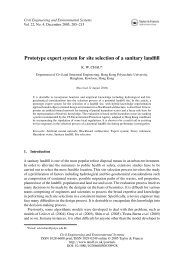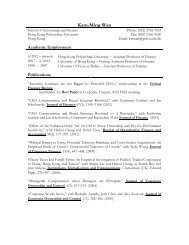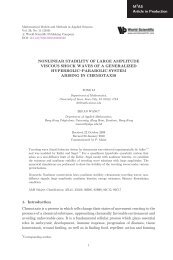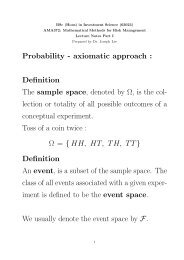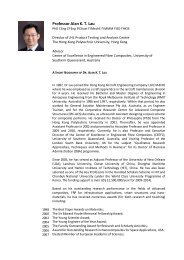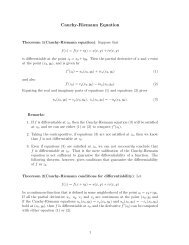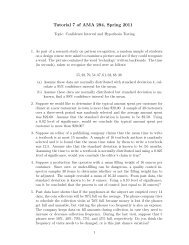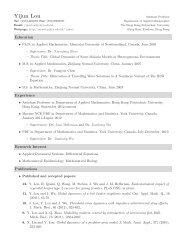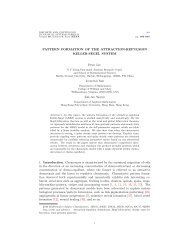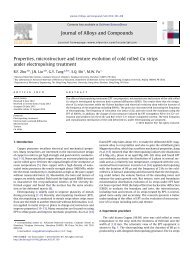98 II. <strong>DETERMINANTS</strong> <strong>AND</strong> <strong>EIGENVALUES</strong>Example 5. Let[ ]0 −1A = .1 0Its characteristic equation is[ ]−λ −1det(A − λI) = det= λ 2 +1=0.1 −λAs you learned in high school algebra, the roots of this equation are ±i where i isthe imaginary square root of −<strong>1.</strong>In such a case, we won’t have much luck in finding eigenvectors in R n for such‘eigenvalues’, since solving the appropriate linear equations will yield solutions withnon-real, complex entries. It is possible to develop a complete theory based oncomplex scalars and complex entries, and such a theory is very useful in certainareas like electrical engineering. For the moment, however, we shall restrict ourattention to the theory in which everything is assumed to be real. In that context,we just ignore non-real, complex roots of the characteristic equationAppendix. Proof of the linear independence of sets of eigenvectorsfor distinct eigenvalues. Assume {v 1 , v 2 ,...,v k } is not a linearly independentset, and try to derive a contradiction. In this case, one of the vectors in the setcan be expressed as a linear combination of the others. If we number the elementsappropriately, we may assume that(7) v 1 = c 2 v 2 + ···+c k v r ,where r ≤ k. (Before renumbering, leave out any vector v i on the right if it appearswith coefficient c i = 0.) Note that we may also assume that no vector which appearson the right is a linear combination of the others because otherwise we could expressit so and after combining terms delete it from the sum. Thus we may assume thevectors which appear on the right form a linearly independent set. Multiply (7) onthe left by A. We get(8)Av 1 = c 2 Av 2 + ···+c k Av kλ 1 v 1 =c 2 λ 2 v 2 +...c k λ k v kwhere in (8) we used the fact that each v i is an eigenvector with eigenvalue λ i .Now multiply (7) by λ 1 and subtract from (8). We get(9) 0 = c 2 (λ 2 − λ 1 )v 2 + ···+c k (λ k −λ 1 )v k .Not all the coefficients on the right in this equation are zero. For at least one ofthe c i ≠ 0 (since v 1 ≠ 0), and none of the quantities λ 2 − λ 1 ,...λ k −λ 1 is zero.It follows that (9) may be used to express one of the vectors v 2 ,...,v k as a linearcombination of the others. However, this contradicts the assertion that the set ofvectors appearing on the right is linearly independent. Hence, our initial assumptionthat the set {v 1 , v 2 ,...,v k }is dependent must be false, and the theorem is proved.You should try this argument out on a set {v 1 , v 2 , v 3 } of three eigenvectors tosee if you understand it.
4. <strong>EIGENVALUES</strong> <strong>AND</strong> EIGENVECTORS FOR n × n MATRICES 99Exercises for Section 4.<strong>1.</strong> Find the eigenvalues and eigenvectors for each of the following matrices. Usethe method given in the text for solving the characteristic equation if it has degreegreater[ than two. ]5 −3(a) .2 0⎡⎤3 −2 −2(b) ⎣ 0 0 1⎦.1 0 −1⎡⎤2 −1 −1(c) ⎣ 0 0 −2⎦.0 1 3⎡⎤4 −1 −1(d) ⎣ 0 2 −1⎦.1 0 32. You are a mechanical engineer checking for metal fatigue in a vibrating system.Mathematical ⎡ analysis reduces the problem to finding eigenvectors for the matrixA = ⎣ −2 1 0⎤⎡1 −2 1⎦. A member of your design team tells you that v = ⎣ 1 ⎤1 ⎦ is0 1 −21an eigenvector for A. What is the quickest way for you to check if this is correct?3. As in⎡the previous problem, some other member of your design team tells youthat v = ⎣ 0 ⎤0 ⎦ is a basis for the eigenspace of the same matrix corresponding to0one of its eigenvalues. What do you say in return?4. Under what circumstances can zero be an eigenvalue of the square matrixA? Could A be non-singular in this case? Hint: The characteristic equation isdet(A − λI) =0.5. Let A be a square matrix, and suppose λ is an eigenvalue for A with eigenvectorv. Show that λ 2 is an eigenvalue for A 2 with eigenvector v. What about λ n andA n for n a positive integer?6. Suppose A is non-singular. Show that λ is an eigenvalue of A if and only ifλ −1 is an eigenvalue of A −1 . Hint. Use the same eigenvector.7. (a) Show that det(A−λI) is a quadratic polynomial in λ if A isa2×2 matrix.(b) Show that det(A − λI) is a cubic polynomial in λ if A isa3×3 matrix.(c) What would you guess is the coefficient of λ n in det(A − λI) for A an n × nmatrix?8. (Optional) Let A be an n × n matrix with entries not involving λ. Prove ingeneral that det(A − λI) is a polynomial in λ of degree n. Hint: Assume B(λ) isann×nmatrix such that each column has at most one term involving λ and that term



